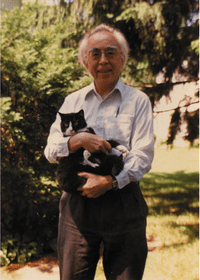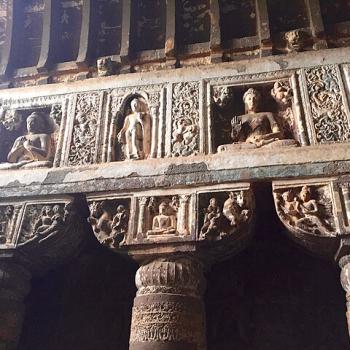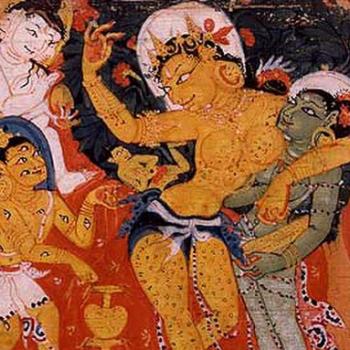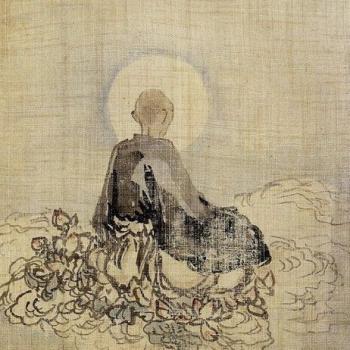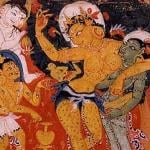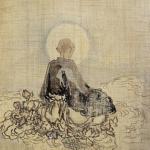Emptiness is Suchness
First published in the Eastern Buddhist & later reprinted in the anthology of Kyoto School reflections, the Buddha Eye, as well as elsewhere. There are reasons for its popularity.
What makes this essay so important to me is how it expresses the fullness of the evolution of Buddhist thinking about emptiness, here traveling through the first uses attributed to the Buddha in the Nikayas, to the Prajanaparamitia literature, to the disruptive assertions of Nagarjuna, to the Madhyamika and Yogacara schools that followed Nagarjuna, then that fateful encounter with Neo-Taoism, and the richness of what I’ve come to call Buddhism with Chinese characteristics, flowering in my life as Zen.
For me each of these views of emptiness are complete in themselves. And all are angles from which to enter the great mystery. Of course, every perspective on emptiness while discrete, is also connected, through history and influence. Of course we need to be cautious in claiming something is the summa of an evolutionary arc.
That noted, and with that caution, what we come to in the Kyoto School’s emptiness, and specifically as presented by Sensei Abe also presents something which contains all that preceded it, is in a sense all those things, and yet, opens doors for the spiritual pilgrim.
JIF
Buddhists emphasize “emptiness” and say that everything is empty. While this is a very important point for Buddhism in general and for Zen in particular, I am afraid that it is quite misleading, or at least very difficult to understand, particularly for the Western mind. I think that “Everything is empty” may be more adequately rendered in this way: “Everything is just as it is.” A pine tree is a pine tree, a bamboo is a bamboo, a dog is a dog, a cat is a cat, you are you, I am I, she is she. Everything is different from everything else. And yet, so long as one and everything retain their uniqueness and particularity, they are free from conflict among themselves. This is the meaning of the saying that everything is empty.
A pine tree has no sense of superiority over bamboo; bamboo has no sense of inferiority to a pine tree. A dog has no sense of superiority over a cat, a cat no sense of inferiority to a dog. We human beings may think that plants and animals entertain such thoughts, but this is merely a projection of human capacities onto the non- human dimension. In fact, plants and animals do not have such a mode of consciousness; they just live naturally, without any sense of evaluation. But human beings are different: we often think of our- selves in comparison to others. Why is he so intelligent? Why am I not as gifted? Why is she so beautiful? Why am I not as beautiful? Some feel superior to others while some feel inferior.
This is because, unlike plants and animals, we human beings possess self-consciousness, and because we are self-conscious we look at ourselves from the outside, through comparison with others.
Although we are “self,” we are not really “self,” because it is from the outside that we look at ourselves. In our daily life, there are moments when we are “here” with ourselves—moments in which we feel a vague sense of unity. But at other moments we find ourselves “there”—looking at ourselves from the outside.
We fluctuate between here and there from moment to moment: homeless, without any place to settle. Within ourselves there is always a breach. On the other hand, plants and animals are just as they are because they have no self-consciousness; they cannot look at themselves from the outside. This is the essential difference between human beings and other living beings.
This characteristic of human beings has a positive aspect. Since we have self-consciousness and are always thinking of something, we can plan, reflect, conceive ideals, and can thus create human cul- ture, science, art, and so forth. As we live, we are all the while thinking how to live, how to develop our lives. This positive aspect, however, is at the same time somewhat problematic, because, as I mentioned above, by means of self-consciousness we look at ourselves from the outside. We are thus separated from ourselves. We are here and there, there and here. We are constantly moving between here and there, between inside and outside. This is the rea- son for our basic restlessness, or fundamental anxiety, which plants and animals do not have. Only human beings are not “just as they are.”
D. T. Suzuki often spoke of “suchness” or “as-it-is-ness.” Plants and animals are living in their “suchness.” But we human beings are sep- arated from our suchness, are never “just-as-we-are.” So far as we are moving between here and there, between inside and outside, looking at ourselves in comparison with others, and looking at ourselves from the outside, we are always restless. This restlessness or anxiety is not something accidental to man, peculiar to certain individuals and not to others. It is not that some have this inner restlessness while others do not. Insofar as one is a human being, one cannot escape this basic anxiety. In fact, strictly speaking it is not that one has this anxiety, but rather that one is this anxiety.
How can we overcome this fundamental restlessness and return to suchness? To do so is the raison d’être and essential task of religion.
According to Genesis, whenever God created something, he “saw that it was good.” When God created Adam and Eve, he blessed them and saw that they too were good. Are we to suppose that the term good in this context is meant in the merely ethical sense? I think not. When God saw that his creation was good, he was not referring to the merely ethical dimension. Rather he was indicating that all of creation was ontologically good, or, to use D. T. Suzuki’s term, that all of creation is in “suchness.”
God created a tree just as a tree, and saw that it was good: it is in “suchness” as a tree. He created a bird: it is really a bird, not a fish. When he created a fish, it is really a fish—very different from a bird. Everything is in its own “suchness.” It was the same when he creat- ed Adam and Eve as it had been with plants and animals and other beings, Adam is really Adam, Eve is really Eve. Adam is good. Eve is good. They are just as they are, respectively and equally. They thus symbolize the original (true) nature of man.
But according to Genesis, Adam and Eve ate the fruit of knowledge—of the knowledge of good and evil. Does this indicate good and evil only in the ethical sense? In my view, the story illustrates far more than that. The eating of the fruit suggests the making of value judgments. You may say, for instance “Today we have good weather, but yesterday we had bad weather,” or “This is a good road, but that one is bad.” Here, the terms good and bad can be made to apply to the weather, the road conditions, etc. It is in this broader sense of knowing good and evil that the fruit of knowledge symbolizes the ability to make value judgments.
The ability to make value judgments is a quality unique to self- consciousness. With self-consciousness one can judge “This is good” or “That is bad,” and so forth. In this way we make distinctions between this and that. We love this and hate that, pursue this and avoid that. Through this capacity for making distinctions, people come to be involved in attachments. Love is a positive attachment. Hate is a negative attachment. By making distinctions, we come to like some things and dislike others. And in this way we become attached to some things and reject others—rejection being the neg- ative form of attachment. We are involved in and confined by our attachments. This is the result of having self-consciousness.
By means of self-consciousness we also make a distinction between ourself and others. As a consequence of this distinction, we become attached to the self, making ourselves the center of the world. We become involved in and limited by the distinction between self and others, the duality between love and hate, and so forth. Distinction turns into opposition, conflict and struggle as soon as the distinction becomes an object of attachment.
But this is not the state of man’s original nature. As God saw, Adam is good and Eve is good, just as plants and animals in their original states are good. Fundamentally everything in the order of original creation is good.
Thus the question is: How can we return to that original goodness, our original suchness? Christianity, I think, has its own answer to this question. In Christianity self-consciousness—the result of eating the fruit of knowledge—is regarded as “sin,” inasmuch as eating the fruit constitutes rebellion against the word of God, who said, “Thou shalt not eat.” It is through the reunion of man and God by virtue of Jesus Christ’s redemptive love that man can return to his original suchness. In Buddhism self-consciousness is regarded as “ignorance,” inasmuch as in self-consciousness we lose the reality of “suchness,” and are limited by our viewing of things in the universe from the outside. As such we even view ourselves from the outside. This outside view of ourselves constitutes the fundamental ignorance inherent in human existence.
Trying to grasp one’s self by one’s self from the outside may be likened metaphorically to a snake trying to swallow its own tail. When the snake bites its tail, it makes a circle. And the more it tries to swallow its tail, the smaller that circle becomes. When the snake carries this effort to swallow its own tail to its final conclusion, the circle turns into a small dot, until finally it must disappear into emptiness. In more concrete terms, the snake must die through its effort. As long as the human self tries to take hold of itself through self-consciousness (out of which feelings of inferiority, superiority, etc. develop), the human ego-self falls into an ever-deepening dilemma. At the extreme point of this dilemma, the ego can no longer support itself and must collapse into emptiness. When the attempt of self-consciousness to grasp itself is pressed to its ultimate conclusion, the human ego must die. The realization of no-self is a necessity for the human ego. Some individuals only come to realize the necessity of confronting this dilemma on their deathbed. Others may existentially intuit the need for resolving this dilemma while still quite young, and thus embark on a religious quest. In any event, the realization of no-self is a “must” for the human ego. We must realize that there is no unchanging, eternal ego-self.
In order to realize emptiness or suchness it is essential to face this dilemma and to break through it. This realization of emptiness is a liberation from that dilemma which is existentially rooted in human consciousness. Awakening to emptiness, which is disclosed through the death of the ego, one realizes one’s “suchness.” This is because the realization of suchness is the positive aspect of the realization of emptiness.
In this realization you are no longer separated from yourself, but are just yourself. No more, no less. There is no gap between you and yourself: you become you. When you realize your own suchness, you realize the suchness of everything at once. A pine tree appears in its suchness. Bamboo manifests itself in its suchness. Dogs and cats appear in their suchness as well. A dog is really a dog. No more, no less. A cat is really a cat. No more, no less. Everything is realized in its distinctiveness.
Then for the first time you come to understand the familiar Zen phrases: “Willows are green, flowers are red,” or “The eyes are hor- izontal, the nose is vertical.” Trees, birds, fish, dogs or cats—from the beginning they always enjoy their suchness. Only man has lost that suchness. He is in ignorance. Therefore he does not know the reality of human life and becomes attached to his life and fears his death. But when ignorance is realized for what it is through the realization of no-self, one may waken to “suchness,” in which everything is realized in its uniqueness and particularity.
This is, however, not just a goal to be reached. It is rather the point of departure for life, for real activity, for “suchness” is the ground of both our being and the world. Not sometime in the future, but here and now we can immediately realize “suchness,” because we are never separated from “suchness,” not even for a moment. It is the ground to which we must return and from which we must start. Without the realization of suchness as our ground or point of departure, our life is restless and groundless. Once we return to that point of suchness, everything is realized in its distinctiveness. The distinctions between self and other, good and evil, life and death are regrasped in the new light of “suchness.” It becomes then the real point of departure for our lives and our activ- ity. However rich or poor in ability we may be, we display that abili- ty in its fullness just as it is, without getting entangled in any feelings of inferiority or superiority. It does not matter whether your ability is grade three, grade five, or eight. You display your own power just as it is, at any given moment and according to any given situation, and can create something new. You can live your life really and fully, without creating conflict with others, so that every day becomes a good day. This is what is meant by the saying “Everything is empty.”


